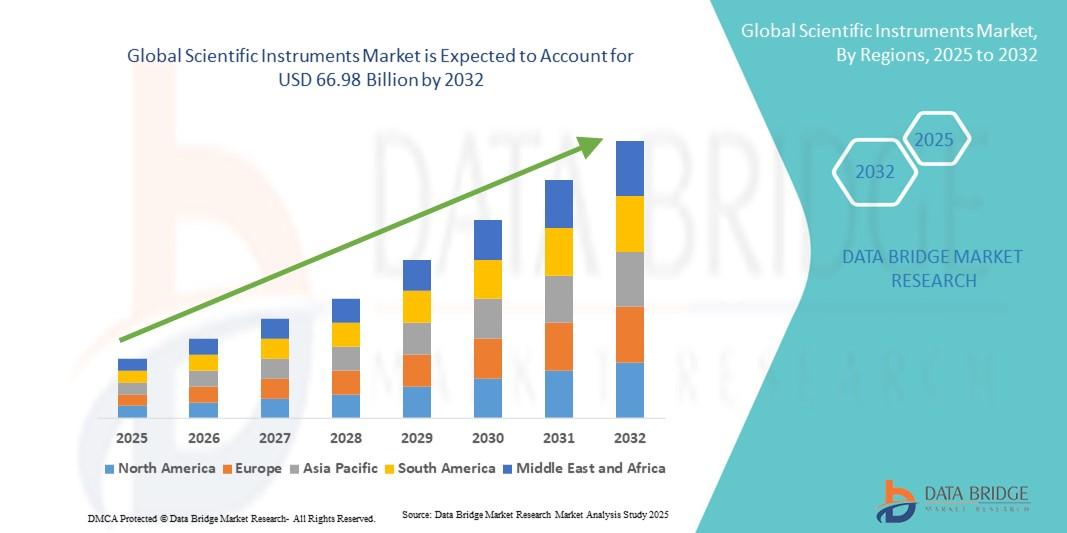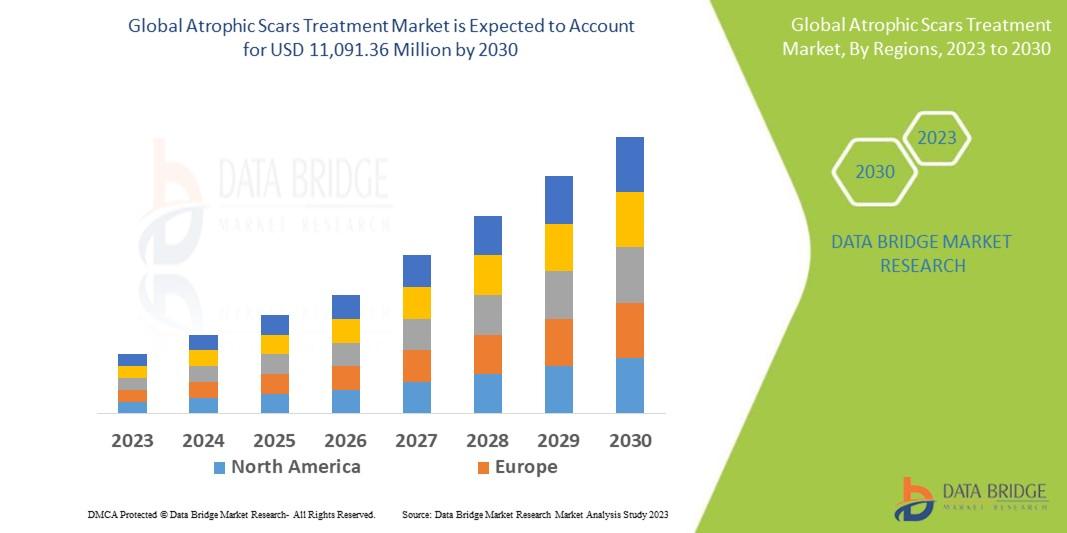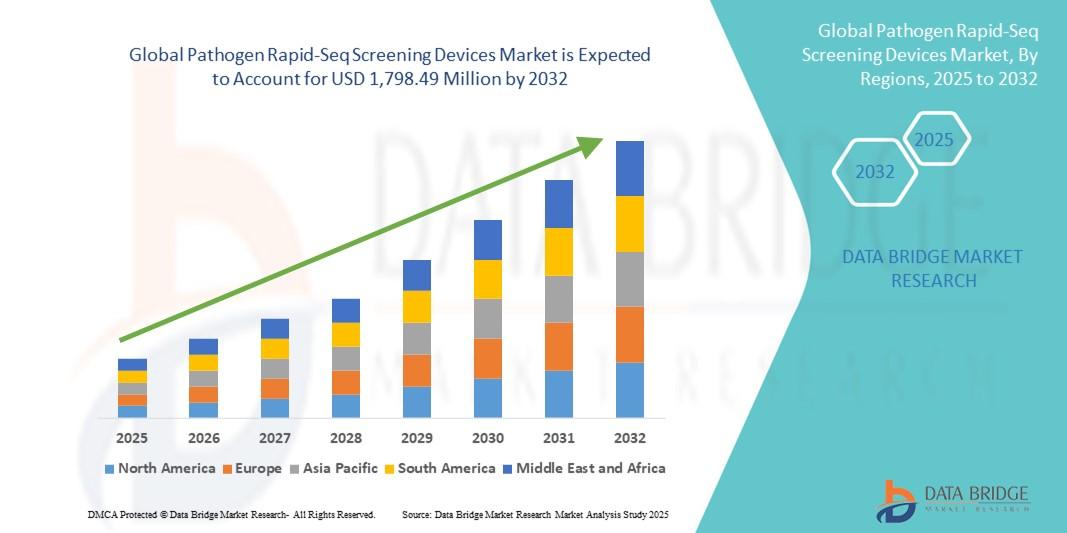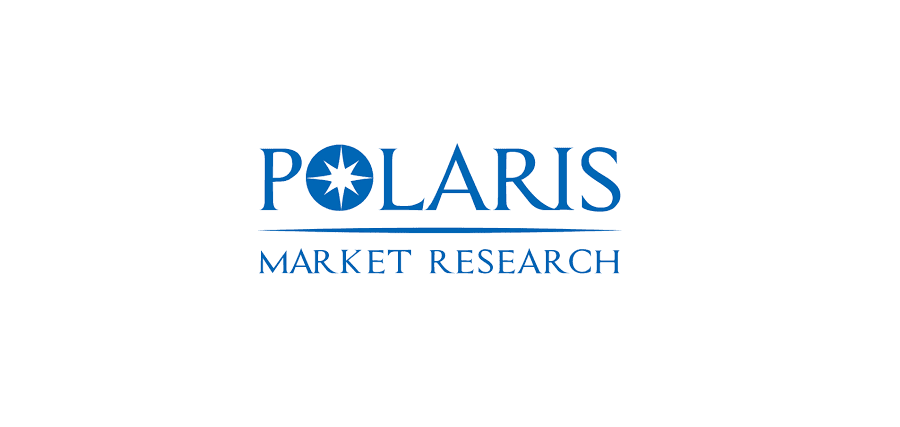Scientific Instruments Market Trends and Growth Analysis with Forecast by Segments

Global Executive Summary Scientific Instruments Market: Size, Share, and Forecast
Scientific Instruments Market Size
- The global scientific instruments market size was valued at USD 46.39 billion in 2024 and is expected to reach USD 66.98 billion by 2032, at a CAGR of 4.7% during the forecast period
- The market growth is largely fueled by increasing research and development activities across pharmaceuticals, biotechnology, and material sciences, coupled with advancements in precision instrumentation and analytical technologies
- Furthermore, rising demand for accurate measurement, testing, and monitoring solutions in laboratories, healthcare, and industrial applications is establishing scientific instruments as essential tools for innovation and quality control. These converging factors are accelerating the adoption of advanced scientific instruments, thereby significantly boosting the industry's growth
Scientific Instruments Market business report provides data on patterns, improvements, target business sectors, materials, limits, and advancements. With this market report, it becomes possible to gain a holistic view of the market effectively and then also benchmark all the companies in the Scientific Instruments Market industry. Moreover, it works to determine the impact of buyers, substitutes, new entrants, competitors, and suppliers on the market. This gives more accurate understanding of the market landscape, issues that may affect the industry in the future, and how to best position specific brands. An influential Scientific Instruments Market research document estimates the existing state of the market, market size and market share, revenue generated from the product sale, and necessary changes required in the future products.
The significant Scientific Instruments Market research report contains historic data, present market trends, environment, technological innovation, upcoming technologies and the technical progress in the related industry. The research studies involved in this market report helps to estimate several important aspects that includes but are not limited to investment in a rising market, success of a new product, and expansion of market share. Key data and information used while preparing this report has been collected from the consistent sources that range from journals, websites, research papers, case studies, and magazines. Scientific Instruments Market report works as a backbone for the growth of Scientific Instruments Market industry.
Stay ahead with crucial trends and expert analysis in the latest Scientific Instruments Market report.Download now:
https://www.databridgemarketresearch.com/reports/global-scientific-instruments-market
Scientific Instruments Industry Overview
Segments
- By Technology:
The global scientific instruments market can be segmented based on technology into spectroscopy, chromatography, flow cytometry, polymerase chain reaction, immunoassay, microarray, and others. Spectroscopy technology is extensively used in various industries such as healthcare, pharmaceuticals, and environmental monitoring for analyzing the chemical composition of substances. Chromatography is another key segment that is widely utilized for separating and analyzing complex mixtures. Flow cytometry is highly valuable for cell analysis and sorting, making it crucial in fields like immunology and cancer research.
- By End-User:
End-user segmentation of the scientific instruments market includes pharmaceutical and biotechnology companies, academic and research institutes, hospitals and diagnostic labs, and others. Pharmaceutical and biotechnology companies are the primary users of scientific instruments for drug discovery, development, and quality control processes. Academic and research institutes heavily rely on scientific instruments for various research activities across disciplines. Hospitals and diagnostic labs utilize scientific instruments for medical diagnostics, pathology, and patient care.
- By Region:
Geographically, the global scientific instruments market is segmented into North America, Europe, Asia-Pacific, Latin America, and Middle East & Africa. North America holds a significant market share due to the presence of leading pharmaceutical companies, research institutions, and advanced healthcare infrastructure. Europe follows closely behind with a strong emphasis on research and innovation in the scientific field. The Asia-Pacific region is experiencing rapid growth driven by increasing investments in healthcare, rising research activities, and expanding academic collaborations.
Market Players
- Thermo Fisher Scientific Inc.
- Agilent Technologies, Inc.
- Merck KGaA
- PerkinElmer Inc.
- Bruker
- Waters Corporation
- Shimadzu Corporation
- Danaher
- Hitachi High-Tech Corporation
- JEOL Ltd.
These market players are key contributors to the global scientific instruments market, offering a wide range of products such as mass spectrometers, chromatography systems, flow cytometers, and more. They focus on technological advancements, strategic partnerships, and new product launches to maintain their competitive edge in the market. Collaborations with research institutions and investment in R&D activities are common strategies adopted by these companies to drive innovation and meet evolving customer demands.
The global scientific instruments market is poised for significant growth driven by advancing technologies and increasing demand across various industries. One emerging trend in the market is the integration of artificial intelligence and machine learning capabilities into scientific instruments, enabling faster and more accurate data analysis. This trend is expected to streamline research processes and enhance efficiency in data interpretation. Additionally, the shift towards personalized medicine is creating opportunities for the development of innovative scientific instruments tailored for individual patient needs.
Moreover, the growing focus on sustainability and environmental consciousness is influencing market players to develop eco-friendly instruments with reduced energy consumption and waste generation. This shift towards green technologies is not only driven by regulatory requirements but also by consumer preferences for environmentally responsible products. Market players are increasingly investing in research and development to create sustainable scientific instruments that align with the global sustainability goals.
Another key aspect shaping the scientific instruments market is the increasing adoption of automation and robotics in laboratory processes. Automation offers benefits such as increased accuracy, repeatability, and efficiency in data collection and analysis. Integration of robotics in scientific instruments allows for high-throughput analysis, making it ideal for handling large sample volumes and complex experiments. This trend towards automation is expected to revolutionize laboratory workflows and enable scientists to focus more on data interpretation and decision-making.
Furthermore, the rise of digitalization and data management solutions in scientific instruments is transforming how researchers collect, store, and analyze data. Cloud-based platforms and advanced software applications are enabling real-time data sharing and collaboration among research teams, regardless of their geographical locations. This digital transformation is enhancing research productivity and accelerating the pace of scientific discoveries.
In conclusion, the global scientific instruments market is evolving rapidly, driven by technological advancements, changing consumer preferences, and industry trends. Market players are poised to capitalize on these opportunities by focusing on innovation, sustainability, and digitalization strategies. The future of the scientific instruments market holds immense potential for growth and development, with a focus on catering to the evolving needs of researchers and scientists across various sectors globally.The global scientific instruments market is undergoing significant transformation fueled by technological advancements, shifting industry trends, and changing consumer demands. One key aspect shaping the market is the integration of artificial intelligence (AI) and machine learning (ML) capabilities into scientific instruments. This integration is revolutionizing data analysis processes by enabling faster and more accurate interpretation of complex datasets. The adoption of AI and ML in scientific instruments is streamlining research processes, enhancing efficiency, and paving the way for more innovative discoveries across various industries such as healthcare, pharmaceuticals, and environmental monitoring.
Moreover, the market is witnessing a notable trend towards personalized medicine, driving the development of innovative scientific instruments tailored to individual patient needs. This shift towards personalized healthcare is creating opportunities for market players to introduce advanced technologies that can provide precise diagnostics and targeted treatments. The emphasis on personalized medicine is expected to drive the demand for specialized scientific instruments that can deliver customized solutions for improved patient outcomes.
Additionally, sustainability and environmental consciousness are playing a crucial role in shaping the scientific instruments market. Market players are increasingly focusing on developing eco-friendly instruments with reduced energy consumption and waste generation. The push towards green technologies is influenced by regulatory requirements as well as consumer preferences for environmentally responsible products. Companies are investing in research and development to create sustainable scientific instruments that align with global sustainability goals, thereby catering to the growing demand for environmentally friendly solutions in the market.
Furthermore, the increasing adoption of automation and robotics in laboratory processes is revolutionizing the way scientific research is conducted. Automation offers benefits such as enhanced accuracy, repeatability, and efficiency in data collection and analysis. The integration of robotics in scientific instruments enables high-throughput analysis, making it ideal for handling large sample volumes and complex experiments. This trend towards automation is poised to transform laboratory workflows, allowing scientists to focus more on data interpretation and decision-making rather than manual tasks.
Lastly, the rise of digitalization and data management solutions in scientific instruments is reshaping how researchers collaborate, share data, and conduct analyses. Cloud-based platforms and advanced software applications are facilitating real-time data sharing and collaboration among research teams globally. This digital transformation is enhancing research productivity, accelerating the pace of scientific discoveries, and fostering innovation in the scientific instruments market.
In conclusion, the dynamic evolution of the global scientific instruments market is driven by a combination of technological innovation, industry trends, and changing consumer demands. Market players that are proactive in embracing these advancements and aligning their strategies with sustainability, personalized medicine, automation, and digitalization are well-positioned to thrive in this rapidly evolving landscape. The future of the scientific instruments market holds vast opportunities for growth and development, with a strong focus on meeting the evolving needs of researchers and scientists across diverse sectors worldwide.
Access detailed insights into the company’s market position
https://www.databridgemarketresearch.com/reports/global-scientific-instruments-market/companies
Alternative Research Questions for Global Scientific Instruments Market Analysis
- What is the estimated market value of the Scientific Instruments Market in 2025?
- What is the forecasted annual growth of the Scientific Instruments Market?
- Which industries are key consumers in the Scientific Instruments Market segmentation?
- Which companies are currently investing heavily in the Scientific Instruments Market?
- What are the most recent product innovations in the Scientific Instruments Market?
- What global regions are comprehensively covered in the Scientific Instruments Market analysis?
- Which region is expanding the fastest in terms of market penetration?
- What countries are emerging leaders in the Scientific Instruments Market?
- What region dominated the market last year?
- What are the top three market trends in the Scientific Instruments Market?
Browse More Reports:
Global Garden and Lawn Tools Market
Global Prepreg Market
Global Quantum Communication Market
Global Automotive Ethernet Testing Market
Global Microscopes Slides Market
Global Self-Service Business Intelligence (BI) Market
Global Sterile and Antiviral Packaging Market
Global Vertical Turbine Pump Market
Global Antimicrobials Market
Global Wireless Radio Frequency Transceivers Market
North America Tissue Paper Market
Europe Paper and Paperboard Packaging Market
Middle East and Africa Melanoma Cancer Diagnostics Market
Europe Invisible Orthodontics Market
Asia-Pacific Flow Cytometry Market
About Data Bridge Market Research:
An absolute way to forecast what the future holds is to comprehend the trend today!
Data Bridge Market Research set forth itself as an unconventional and neoteric market research and consulting firm with an unparalleled level of resilience and integrated approaches. We are determined to unearth the best market opportunities and foster efficient information for your business to thrive in the market. Data Bridge endeavors to provide appropriate solutions to the complex business challenges and initiates an effortless decision-making process. Data Bridge is an aftermath of sheer wisdom and experience which was formulated and framed in the year 2015 in Pune.
Contact Us:
Data Bridge Market Research
US: +1 614 591 3140
UK: +44 845 154 9652
APAC : +653 1251 975
Email:- corporatesales@databridgemarketresearch.com




